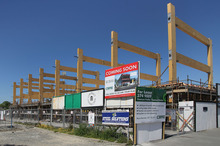From Property Council Newsletter:
EARTHQUAKE-PRONE BUILDINGS: TAXATION ISSUES PART TWO
Following intensive advocacy efforts by Property Council and our members, key Government Ministers are seriously contemplating tax relief for earthquake strengthening after coming to grips with the scale of the problem facing our industry.
Evidence of Ministers considering financial relief can be found in interviews on ONE NEWS with Associate Revenue Minister Peter Dunn in July and with Building and Housing Minister Hon Maurice Williamson last week. The comments made by Hon Williamson are particularly pleasing, as Property Council has been pushing for recognition and action on this issue since February 2012 in a series of meetings with officials from the Department of Building and Housing and the newly formed Ministry of Business, Innovation and Employment (MBIE).
The latest word from the Beehive is that officials are peer reviewing papers on the viability of providing some form of tax relief for strengthening. This is positive news. Our next steps will be to continue meeting with Ministers to push our message home, ensuring it gets traction and making sure any talk is followed through with.
With the weight of our membership behind us, we are sure to get movement on this issue. Now more than ever, your support is essential. Thank you for your commitment to us so far.
Connal Townsend
Chief Executive
EARTHQUAKE-PRONE BUILDINGS: TAXATION ISSUES PART TWO
Following intensive advocacy efforts by Property Council and our members, key Government Ministers are seriously contemplating tax relief for earthquake strengthening after coming to grips with the scale of the problem facing our industry.
Evidence of Ministers considering financial relief can be found in interviews on ONE NEWS with Associate Revenue Minister Peter Dunn in July and with Building and Housing Minister Hon Maurice Williamson last week. The comments made by Hon Williamson are particularly pleasing, as Property Council has been pushing for recognition and action on this issue since February 2012 in a series of meetings with officials from the Department of Building and Housing and the newly formed Ministry of Business, Innovation and Employment (MBIE).
The latest word from the Beehive is that officials are peer reviewing papers on the viability of providing some form of tax relief for strengthening. This is positive news. Our next steps will be to continue meeting with Ministers to push our message home, ensuring it gets traction and making sure any talk is followed through with.
With the weight of our membership behind us, we are sure to get movement on this issue. Now more than ever, your support is essential. Thank you for your commitment to us so far.
Connal Townsend
Chief Executive





Comment